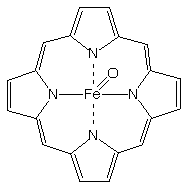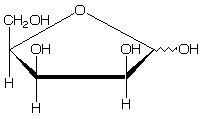
a) Lowest energy structure for cyclodecane (25 points).

MM3 is probably the best choice, because
the force field was specifically parameterized for problems like
hydrocarbon conformational analysis. The OPLS force field might
also work, but it was developed for proteins and dynamics simulations,
so there is less likelihood that it will be robust. Semiempirical
models are not, as a rule, very good for conformational analysis
problems like this one. Moreover, there are potentially dozens
if not hundreds of possible minima, and it would be computationally
intensive to try to find them all at the semiempirical level.
b) UV spectrum (i.e., energies to reach excited electronic states) of iron-oxo porphyrin (25 points).

Only the ZINDO model has parameters
that can handle iron reasonably. Moreover, it was specifically
developed for spectroscopic studies, so it is ideal for this case.
Note that even if iron parameters were available for the force
field methods, they would still not be useful for spectroscopy,
since they are not quantum mechanical in nature, and know nothing
about orbital energies, excited states, etc.
c) Calculation of the gas-phase activation energy for the atmospherically important reaction HO* + HOO* -> H2O + O2 (25 points).
The listed force field methods have
not been parameterized for transition states, so they would not
be useful in calculating the activation barrier (i.e., the energy
of the transition state less the energy of the reactants). Of
the semiempirical methods, AM1 and PM3 are more likely to be useful
since both handle interatomic (and hence intermolecular) interactions
with more flexibility than the older INDO method. Although they
are the best choice, however, that is no guarantee that they will
give reasonable results. Certainly, it is difficult to predict
a priori whether one will be better than the other.
d) "Flexibility" of chymotrypsin in aqueous solution
(a typical way to measure this is to examine the mean-square-displacement
of the a-carbons in the peptide backbone
from their average positions during the course of a dynamics simulation)
(25 points).
Since the mean-square-displacement
of the a-carbons in the peptide backbone must be measured as a
time average, this calculation requires molecular dynamics. Dynamics
on large molecules with semiempirical methods is extremely time-consuming
(if not outright impossible) and they are not very good for conformational
energetics in any case. Of the two force fields, OPLS was specifically
designed for proteins and simulations (OPLS stands for Optimized
Potentials for Liquid Simulations) so it would definitely be the
better choice.
e) Gas-phase dipole moment for the lowest energy structure of the sugar D-lyxose (25 points).

There are two parts to this problem.
First, one must get the lowest energy structure of lyxose, and
then one must calculate the dipole moment. For the latter property,
semiempirical methods are expected to be better because the dipole
moment is an electronic property and force fields don't treat
electrons explicitly (although it is possible that you
could get lucky from calculating simply the dipole moment derived
from all of the force-field partial atomic charges). AM1 and PM3
are better for dipole moments than an INDO method, but it is not
clear that either is to be preferred over the other.
As for the structural problem, theinability of AM1 and PM3 to do very well with hydrogen-bonded systems is worrisome. AM1 does marginally better with intramolecular hydrogen bonds based on limited literature data (this was mentioned in class) so of all the semiempirical methods, it might be expected to be the best. However, the force fields might well do better than the quantum mechanical methods for this problem. We discussed the paper by French et al. that showed MM3 to be well suited to sugar conformational analysis.
As a result, the best approach might
be to optimized the lowest-energy geometry with MM3 and then do
a single-point AM1 or PM3 calculation of the dipole moment at
the MM3 geometry.
f) Pictures of the p orbitals for
pyridine (25 points).

2. Implicit in the above problem was that none of the properties
being calculated was available experimentally. Given that, explain
how you might assess the quality of the answers you get from your
calculations in different instances. You don't have to do this
on a molecule by molecule basis! Rather, I am looking for some
general discussion of how you decide on the trustworthiness of
your results. A good answer will provide some hypothetical situations
for discussion (e.g., I could do x and compare to y
and if situation z were to be true I would draw conclusion
w, etc.) and/or include specific examples which may or
may not be derived from the above problems (50 points).
The only benchmarks available for theoretical results are either trustworthy experimental data or other theoretical results from a higher level that is unimpeachable (the latter is usually hard to get, since if you could do the calculation at the higher level, you wouldn't be wasting your time wondering about your lower level results). But, the premise of the question is that the experimental result is unknown (otherwise, again, why waste your time with the calculation?)
It may be, however, that some other property of the molecule in question is known experimentally. E.g., you might want to calculate the structure of a molecule for which the dipole moment is known. In that case, it is worthwhile to calculate the observed property at the same level of theory and see how you do. One might call this "extrapolation in the property direction".
Alternatively, the property you are interested in might be known experimentally for a closely related molecule/system. In that instance, you would repeat your calculation for the known system and the same level of theory and see how it does. This could be called "extrapolation in the molecular direction".
The degree to which you have to go
in either or both directions before you can make contact with
experiment (or very-high-level theory) should dictate how comfortable
you are with your computational results. There are subtleties
in these extrapolations, as well. For instance, are X-ray crystal
data always relevant to gas-phase calculations (put more generally,
are the experimental conditions relevant to the theoretical ones)?
There are no cut and dried analyses.